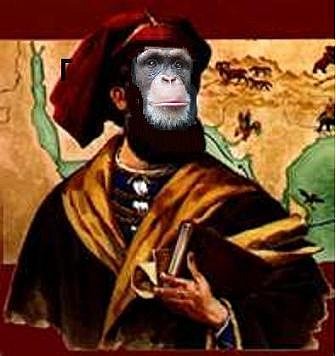Tiki Central / California Events / Mojave Oasis April 20-22 Sold Out
Post #632079 by Rum Dog on Wed, Apr 11, 2012 5:59 PM
|
RD

Rum Dog
Posted
posted
on
Wed, Apr 11, 2012 5:59 PM
THE LEGEND OF GERONCHIMPAMO PART II: Geronchimpimo’s Forefathers & The Direct Link between the Southwest and the South Pacific. Many have scoffed at and chastised the idea of a fusion of Southwest and South Pacific cultures. They even go as far as to call it blasphemous and sacrilegious. Some naively believe that simians have absolutely nothing to do with tiki and have no place in it. But nothing could be further from the truth. Without the ancient Native Apemerican indigenousness populations there would indeed be no South Pacific Oceanic tiki cultures. Monkey Polo (Geronchimpamo’s great, great, great, great, grand uncle) left the American Southwest Mojave Desert in 450 BC in search of new flavors after years of complaining about his wife’s bland cooking. His tastebuds had had enough of cornmeal and mush.
His tastebuds would take him on one of the most historic journies in the history of apekind. His quest took him on a path westward across the Pacific Ocean where he eventually arrived in what was to become the Spice Islands. It was there that he discovered the secret spices and ingredients that would come to be in ApePache Firewater and be passed down generation after generation. Several members of these journeys that began out of Mojave went on to make settlements in these previously uninhabited isles.
Depicted above is an early settlement village in the South Pacific by the descendants of Geronchimpamo’s forefathers. Only the original village settlers who migrated from the Mojave Desert were able to use teepees as there were no indigenous buffalos on the islands.
It was in the Far East where Monkey Polo discovered many other spices and herbs that he eventually brought back to the Mojave Desert. Many of these also became key ingediants in ApePache Firewater. There were also other finds such as special weeds that were native to these new lands. These weeds even had special hallucinogenic powers which are still popular among some modern day tiki enthusiasts who shall remain unnamed. Coming Soon: Part III Direct proof of Early Mojave inhabitants on the South Pacific Isles. |



